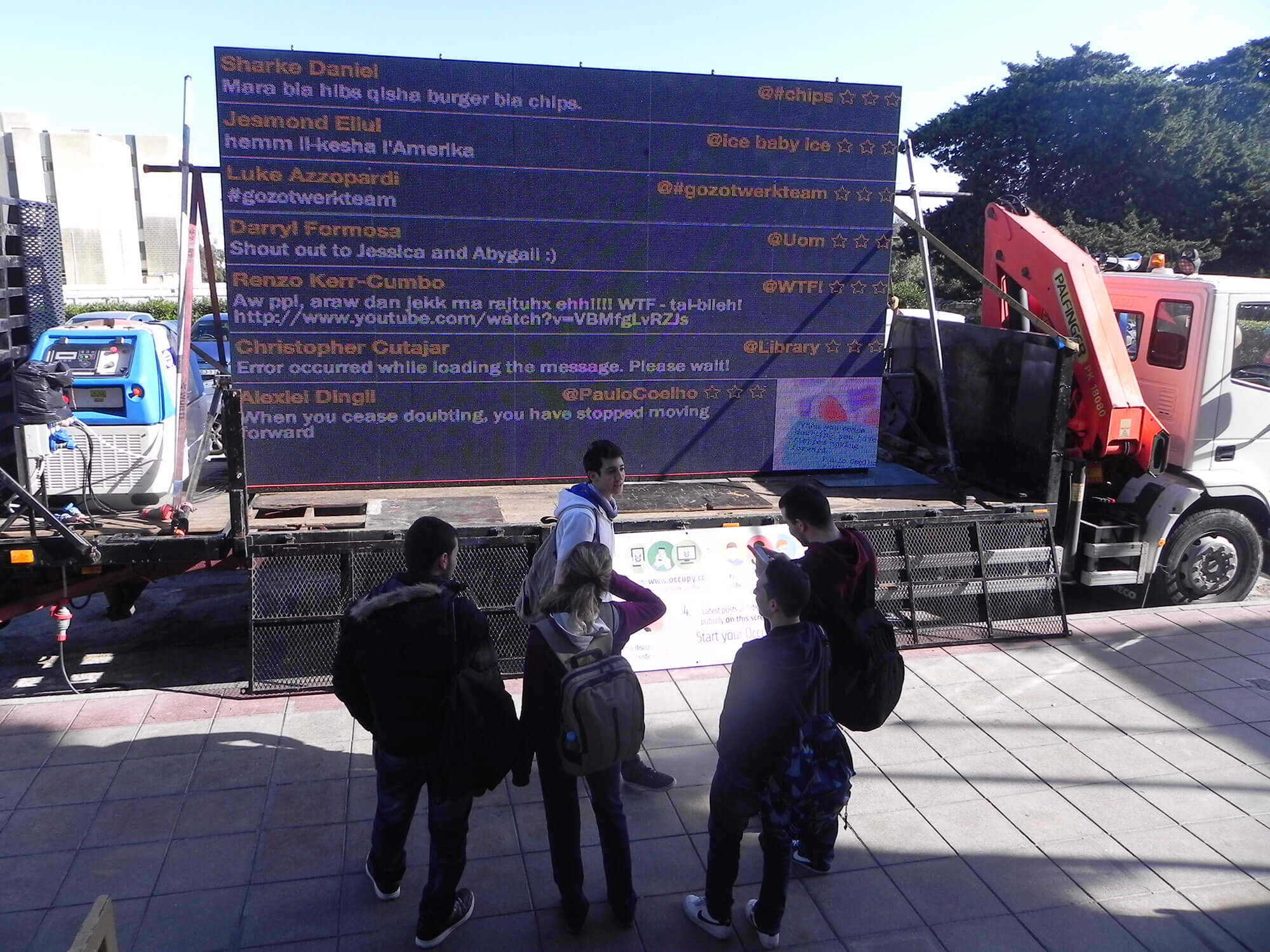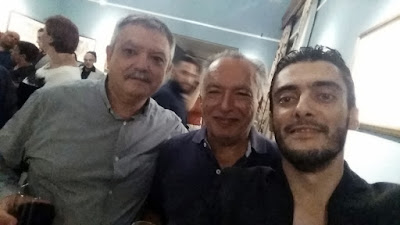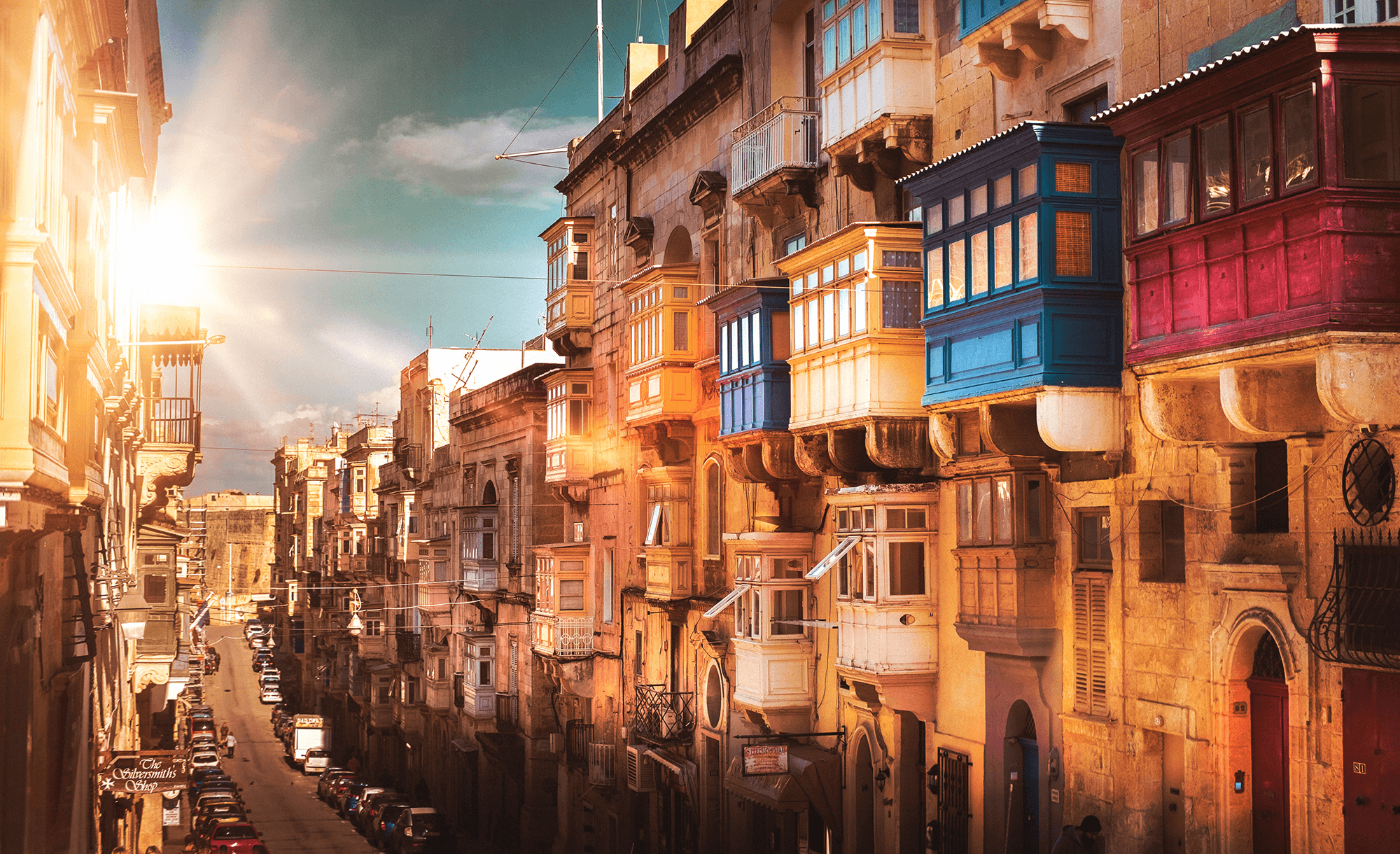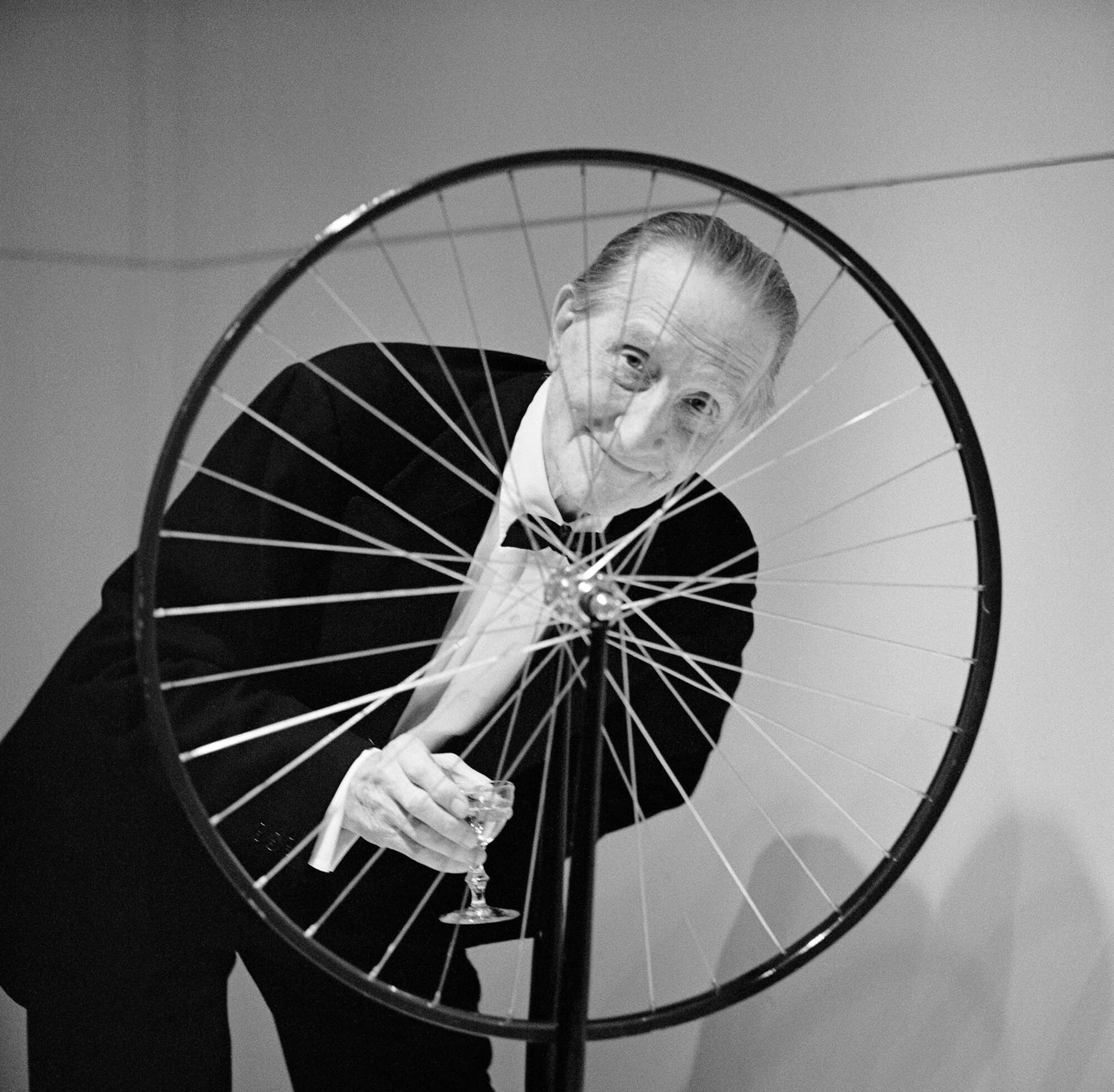
Żfint żifna max-xitan
qalb ix-xewk f’dal-bukket ward
li xtaqt irregalajtlek.
Biex illejla ma naħsibx fik;
inħallik.
Sibt l-inbid li fih skirna.
Ġbart fdal l-ikel bnin
li dewwaqna lil xulxin.
Dak li xtaqt ma ninsiex;
ma narmix.

Żfint żifna max-xitan
qalb ix-xewk f’dal-bukket ward
li xtaqt irregalajtlek.
Biex illejla ma naħsibx fik;
inħallik.
Sibt l-inbid li fih skirna.
Ġbart fdal l-ikel bnin
li dewwaqna lil xulxin.
Dak li xtaqt ma ninsiex;
ma narmix.

What follows is an extract of the aims that led for the completion of the 2014 Master research: “Art as a political choreography through social media: An investigation of social media as a tool and space for art to drive social narratives. The whole document can be accessed through Academia.com here.
The objective of this research is to explore and investigate how art can be envisaged as a driver of social narratives through social media in a bid to trigger and sustain the development of contemporary activism. Whilst web-based Social Networking Sites (SNSs) are generally associated with the sharing and diffusion of information amongst users and their networks, they also provide for a differentiated and customised usage of tools that lie within.
As Danah M.Boyd and Nicole B.Ellison claim: the cultures that emerge around SNSs are varied. Most sites support the maintenance of pre-existing social networks, but others help strangers connect based on shared interests, political views, or activities. Some sites cater to diverse audiences, while others attract people based on common language or shared racial, sexual, religious, or nationality based identities. (Boyd & Ellison, 2007, p. 1)
This study discusses and explores the role that an artistic intervention in digital art could play within collective activism. What can an artistic intervention contribute to the capitalist narratives of social media to regurgitate it into new forms of collective activism? Special attention is given to research and observations by researcher in new media and culture in contemporary global activism Dr Paolo Gerbaudo, in his book Tweets and the Streets– social media and Contemporary Activism (2012).
My two-fold project consists of an art installation that makes use of a custom social networking platform and incorporated mobile technologies, and discusses public participation in the generation of a social narrative. This narrative is displayed, in real-time, on a physical, digital screen to fuel further real-time interaction with the audience. The culmination of the project will be an artwork that represents this interactive process in the form of relational aesthetics – that which Bourriaud (2002) describes as “an art form where the substrate is formed by inter-subjectivity, and which takes being-together as a central theme, the “encounter” between beholder and picture, and the collective elaboration of meaning.” (p.14)
It aims at assisting and mediating for a “choreography of assembly” (Gerbaudo, 2012 p. 12) to take place in public spaces and thus, for art not to be disconnected from life. As hinted in the introduction, interactive participation might not be considered complete if there is a missing transmission or reception end to a communication. Twining (1980) claims that alienation happens “if man interprets or experiences this interaction as destructive, in terms of a loss of control or an emerging negative definition of self, the alienation process is initiated and self-estrangement is the potential outcome.” (Twining, 1980, p. 422).
All along the way, social media aimed at replicating the effect of the ‘old’ newspaper and poster movements and motivate people into new relations. Yet, some argue, they might have peculiarly contributed to further distancing. That is where art can play its distinctive role in the “remaking of the experience of the community in the direction of greater order and unity” (Dewey, 1980, p. 81). This would be a role of mediation between alienation and activism.
Ilbieraħ kelli waħda minn dawk is-serati b’dilemmi. Żewġ stediniet, mill-aktar apprezzati, għal avvenimenti, tista’ tgħid fl-istess ħin. Bħalma saret rutina fl-aħħar sentejn, għamilt il-pjanijiet waħdi, sabiex nipprova nduq l-emozzjoni tat-tnejn.
L-ewwel mawra ħaditni sal-belt kapitali l-antika, l-iMdina. Il-vjaġġ, għal kuntrarju ta’ dak li rrakkuntaw in-nies fuq Facebook matul il-jum, kien ħafif u bla ntoppi. Inċidejt wieħed biss meta wieħed pretenda li nakkomodah u ngħatih id-dritta anki jekk kien qed jikser ir-regoli tat-traffiku u ntefa’ jsegwini, ipaqpaq u jżewwaq xi kliem li ma stajtx nifhem. Fuoco Amico I tal-Verdena tfietu u għall-mument stħajjilt qed nara xena virtwali ta’ dan jitmasħan fil-karozza ta’ ma’ ġenbi!
Ħallejt iċ-ċwievet tal-karozza lil San Pawl tas-Saqqajja u lebbitt lejn il-Palazz De Piro. Hemm sibt lill-President Emeritu Dr Ugo Mifsud Bonnici bħal donnu qed jistennieni għax kif irfist l-għatba tal-gallerija, beda d-diskors għall-ftuħ tal-esibizzjoni t’arti viżiva tal-artist Belti, bravu u ġar tiegħi Paul Caruana.
Sar il-ftuħ u qbadt indur ix-xogħolijiet ta’ Pawlu. X’naqbad ngħid?! Kull kwadru, storja; emozzjoni. Quddiem uħud xtaqt biss ninfaqa’ nibki bi pjaċir u b’nostalġija għal rakkonti li sawwru lil Belti u niesha. Stejjer li sfortunatament tul iż-żmien traskurajna u tista’ tgħid tlifna sakemm fl-aħħar snin stenbaħna u erġajna ntfajna nistaqsu suritna!
Minn lat artistiku, Pawlu Caruana huwa mastru fiż-żebgħa tal-ilma. Ħasra li hawn min jeħel quddiem din it-teknika u jikkategorizzaha bħala arti ‘inqas’ għolja minn oħrajn. Jien li għal kuntrarju ta’ Pawlu naħdem bi pniezel diġitali, nħoss li kull għodda li tintuża għal espressjoni artistika tista’ tiġġenera xogħol medjokri jew xogħol ta’ kwalità. U hawn, fil-każ tas-serje Dear Younger Me ta’ Pawlu Caruana sibt xogħol li jidħol fil-profond tal-ħajja tal-artist iżda wkoll fil-ħajja tal-komunità li fiha huwa trabba. Kif qal sewwa Ugo Mifsud Bonnici, xogħol Pawlu huwa kumment soċjali. Allura nidħak meta naħseb li kien hemm min irrifjuta li juri dan ix-xogħol bl-iskuża tal-lingwa klassika taż-żebgħa tal-ilma.
Bla dubju nħeġġeġ lil ħuti Beltin, Vallettani, sabiex isuqu sal-Belt l-oħra (hux hekk Simon?) u jgħatu titwila lejn il-ħajja u l-istejjer passati fid-Due Balli u ‘l madwar, qalb nisa, anzjani, tfal, fantasija u anki iħirsa.
Kif mistenni ma setax jonqos li nsib lil sieħbi u ex kollega George Cini f’dan l-mument. Belti ieħor jekk Alla jrid! Filfatt Pawlu Caruana kien ikkollabora ma’ George fil-kontenut viżiv tal-ktieb tant famuż ‘Strada Stretta’; il-ktieb li jiena nqis bħala l-katalist uffiċċjali tal-qawmien ta’ din it-triq. Id-diskursati ma’ George dejjem jinżlu għasel; dejjem jgħallimni xi ħaġa ġdida bit-taħdit uniku tiegħu; a-la Beltija!
 |
| Tlett ‘kriminali’ Beltin: Paul Caruana, George Cini, Pawlu Mizzi |
Sar il-ħin u kważi bħal pażtaż, sellimt lil Pawlu u George, ħadna stessu (hekk sewwa u xieraq) u ħrabt ‘l hemm. Soqt sal-iktar raħal li jdejjaqni f’Malta – Tas-Sliema u pparkjajt ġewwa l-parkeġġ tal-iskola St Patrick’s, qalb iħirsa ta’ memorji sbieħ li dejjem jitfaċċaw b’ħafna toqol meta nqarreb ‘l hemm.
Flimkien ma’ sieħbi John u l-kollega Margerita, intfajt nsegwi l-kunċert tal-artist Neil Halstead. Lil Stalko ma’ lħaqthomx; paċenzja! Għal darb’oħra l-promoturi HairyAmp ġabu ismijiet ta’ kalibru kbir u ħadt gost nara li l-udjenza rrispondiet. Jidher li l-Maltin qed jirrealizzaw u jfittxu mużika tajba dejjem aktar. Il-mużika ta’ Halstead hija raffinata; kważi kważi ironika quddiem il-karattru u d-dehra kemmxejn aktar ħorox tiegħu. Ħadt pjaċir ngħalaq għajnejja jew niċċassa lejn is-saqaf u nisma. L-inbid mill-Imdina beda jgħin iżda sa ċertu punt beda’ jtellef ukoll – l-istess bħan-nies iqumu u jpoġġu ‘l ħin kollu!
Wara xarba tajba ma’ ħabib tiegħi f’bar ikrah u bla ruħ ġo tas-Sliema, għaddejt sal-parkeġġ u soqt lura lejn il-Kapitali qalb ħsibiijiet varji u xi ftit rabja wkoll. Stramb dal-moħħ u stramba dil-qalb; bħal donnu reġa’ wasal tmiem il-ġimgħa. X’tgħamel, għażiż Pawlu!?

A local scenario and myself within it
Barthes thesis, which confronts the idea of the image being a weak and elementary medium of communication when compared to language, is truly intriguing. My eleven-year experience as a professional graphic designer keeps reminding me how images create and transmit meaning. Thus, the responsibility granted by Barthes onto the image maker becomes factual. One can discuss whether both the image-maker and the image itself can give birth to new ideologies.
The interpretation of images by the audience is directly influenced by the experience and the relationships they carry along. It is sometimes stronger than the actual language that accompanies visual imagery. And that is why the same image could have a different lasting effect within different cultures. When image is set about for debate, its subjectivity should be always scrutinised before any commentary is made.
Within a Maltese context, the lack of exposure to good art for the locals is source to uninformed/uneducated relationships. I would say the experience is many times inexistent as this is also lacking through the educational system.
Different ideologies can trigger different reactions to the same subject, imagery or interpretation of both. When the term ideology denotes a political vision, popular culture is sculptured into a terrain made of political and social significations.
Unfortunately, censorship within our artistic scenario is still, very tangible. The idea of regulation of expression is the result of ideologies set about by a predominant Catholic Church and a Christian Democratic ruling government.
Yet, in line with German playwright Berolt Brecht, one could luckily affirm that “art is never without consequences”; Duchamp’s “fountain” which declared a rejection of the establishment of art, was an important challenge to the perceptions of people, firmly anchored within their ideologies.
Local ideology works mainly on the religious and the political fronts of society where both linguistics and imagery are used by the establishments to define the common denominators and the ‘dominant culture’. Instances through local history proved such ideologies beneficial, yet, the relevance of both conforming forces today, seem to be quite occult.
On such grounds, my art has in the past years grown sensitive towards these conspiring forces. Starting off through my writing, thus, my linguistic forces, I decided to start describing my emotions related to the local conformism to politics and religion, by using poetry. Following the introduction of social media I made a conscious decision to expose these confronting ideas of mine into public through a blog and facebook.
I have experimented both with creating and exposing art for and through these platforms, but also to reinvent my graphical artistic expression into something that speaks of a heightened awareness in comparison to a, generally, alienated society.

Perspectives on the creative act – What is your perception of art?
“… art is one of the means of intercourse between man and man”
Leo Tolstoy – “What is Art?”
Leo Tolstoy’s statement in his essay “What is Art?” is the one interpretation closest to the real essence of the term as art can exist whenever a man transmits his feelings to another. This, regardless whether the end product is good or bad.
Spontaneous but subjective act which, through men, translates the essential intention of art into a realisation of the same was coined as ‘The Creative Act” by Marcel Duchamp. This becomes whole when the spectator completes the dialogue triangle with the artist and the work of art. It is at this level that the raw state of art is refined.
Art is the solitary act of creation, which doesn’t happen for pleasure’s sake but as a means to a universal conspiracy. In “What is the creative act?”, Gillez Deleuze goes deeper into associating the creative act to a counter reaction in front of a patronizing information system. He calls it “The act of resistance” and links it to Malraux concept of art as the only thing that resists death. Just like every human struggle to resist death, so does art.
The purest act of art is also described as a sort of metaphysical space, which can connect and/or concern different people from different cultures across oceans and geographical boundaries.
The communication of a feeling in a bid to unite other recipients as one block is indeed art, yet, being unsuccessful in transmitting that same feeling across is not crucial. Starting off with the opposite intention could just as well be an act of art. When feelings are translated into movements, colours, sounds, forms, lines or words, the activity gets contagious through the encounter experience of spectators, no matter if this reflects the original concept behind a piece or totally defies it.